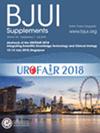Re-defining the interpretation of 24-h urine studies for stone formers
Abstract
Objectives
To identify associations between 24-h urine abnormalities and clinical risk factors for recurrent stone formers.
Patients and methods
The Registry for Stones of the Kidney and Ureter was queried for all patients who underwent 24-h urine studies. Patients were categorised by the number of clinical risk factors for recurrent stone disease. Stone recurrence was calculated by stone events per person-year. We utilised a novel method to calculate an overall severity score for 24-h urine parameters. The stone recurrence and 24-h urinary analyte values were then compared using Student's t-tests, chi-square analysis and negative binomial regression.
Results
A total of 614 stone patients met our inclusion criteria and were categorised by the number of clinical stone risk factors. On adjusted and unadjusted analysis, an escalating number of clinical risk factors predicted increased stone recurrence risk. However, there were no differences in mean 24-h urine analyte values amongst these groups aside from higher urinary calcium. However, after calculation of a 24-h urine severity score there was a significantly higher mean severity as the number of clinical risk factors increased. This severity score also independently predicted stone recurrence on adjusted negative binomial regression.
Conclusions
Utilising a novel 24-h urine scoring system, we showed that higher-risk stone patients have more severe 24-h urine characteristics, which was not apparent using conventional analysis. Both the severity score and clinical characteristics independently identified those at risk of stone recurrence.

 求助内容:
求助内容: 应助结果提醒方式:
应助结果提醒方式:


